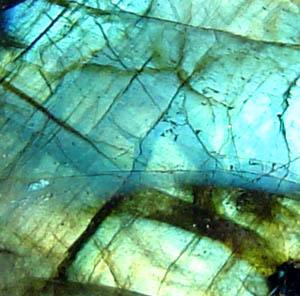Labradorite
|
Named for the coast of Labrador, Canada where it was discovered in 1770 near the locality of Nain by the Moravian mission. It was found in a lagoon, approximately
fifty meters inland, St. Paul's Island. When wet, the locals had a tendency to refer to it as 'fire-stone' on account of its lustrous shine. An optical effect, sometimes referred to 'labradorescence', is responsible for the brilliant luminescent colouration that becomes visible when viewed under light. It is thought to be due to the presence of small amounts of various other minerals in the form of a laminate. Beyond the locale where it was discovered, Labradorite has been discovered in Russia, Finland, the United States, Norway and Australia. |
